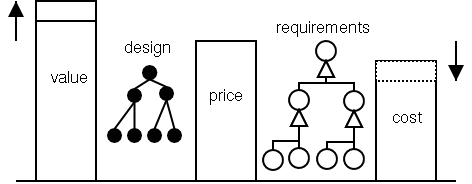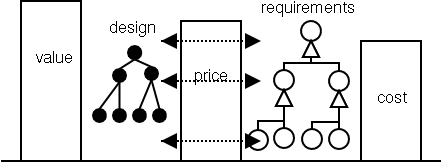Volgende: Conclusions Omhoog: Analysis of new applicable Vorige: Improving market acceptability with Inhoudsopgave
The NG Internet (semantic web, web 2.0) can provide an opportunity to help the BC industry become a knowledge-rich (high-tech) industry with well controlled processes and guaranteed output quality.
In traditional BC, little value is added by each partner in the chains. There is, mostly, only a small difference between actual costs to build the product and value provided to the customer. Assuming that the price sits in between the costs and the value, only little room exists for profit for the Virtual Enterprise that performs the project. Also, relative little extra value is provided for the money spend by the customer.
State-of-the-art web technology can be an instrument to help realise new, dynamic BC processes that give Clients more value for money and construction companies more money for the value provided.
There are three basic avenues that can be pursued. Cost incurred can be lowered, value provided can be increased and, third, interaction between the cost and the value can be streamlined.
The NG Internet dramatically increases possibilities for information and knowledge sharing. Knowledge sharing is at the very least as important as information sharing for the desired knowledge economy. Information is what and how, knowledge is how and why.
With NG Internet possibilities arise firstly for back-and-forth information exchange, allowing the process to become more dynamic. There is improved upstream and downstream information and knowledge exchange, not just a transfer of a fixed document at a fixed point in the process's time after which no exchange is possible or feasible.
Secondly, increased exchange and availability of information also opens up more opportunities for enriching the information with valuable knowledge. Knowledge enrichment is now done by humans in a manual process. When more communication takes place in computer-understandable ways, in combination with a much more fine-grained communication, every one of those communications is an opportunity to (automatically) attach knowledge. For example, continuous checking of the height of the building-being-designed with local regulations; checking suppliers with the in-house observed-quality database when comparing offers; doing an maximum escape route length calculation [91] after each office building design change. This way, new knowledge possibilities are integrated into the BC process that simply are not currently feasible on that level.
These three core solution concepts, improved information sharing, dynamic interaction and knowledge integration are discussed in the next sections. They are coupled with the three improvement avenues, lowering costs, increasing value and streamlining interaction.
An example. A Client revises his opinion and wants to have an extra 10 square meter of paved surface in his garden. The Contractor that contracted the refurbishment of the house changes the project data. The gardener, when buying pavement tiles next week, has this small project change automatically reflected in his item quantities, printed out from the inventory section of the small-company-management web site that he's using to run his company.
Second example. The last-minute political wish to upgrade the plans for the new locks for sea-going vessels to allow a maximum ship length of 180 meters is entered into the project's data. The Water-works Department's cost estimator application is re-run. The cost estimator downloads the revised project data and calculates the new estimate.
Examples like the two above are often far from current reality. The gardener in the first example could just as easily have heard about the Client's changed wishes when arriving to put the pavement in place: with a truck with not enough paving tiles to add the extra 10 square meters. The options are to come back next day with more tiles or to go to get them right now (both costing additional money) or for the Client to do without the extra paved surface (meaning disappointment and less value). All because a simple telephone or fax from the Contractor slipped through the cracks.
Internet is available practically everywhere. On the physical level there is therefore no problem to access information in another location. The NG Internet provides means to make human-readable information available as computer-readable data. In many scenarios, computers could do menial tasks automatically, if only they are given the data to work on. Some of these tasks will free humans to do real value adding work, but other tasks will be tasks that are not even done today, like checking and checking and checking again for errors stored in the company's database of often-recurring errors.
When looking at the level of Client value and construction industry cost, a value adding component is present in NG Internet fueled improved information sharing. But the low-hanging fruit is probably in reducing the costs by eliminating construction or management failures (see figure 4.10).
When looking at the level of Contractor value and supplier costs, some cost effectiveness can be achieved on the supplier side by, for instance, automatic order processing instead of dealing with faxed orders. The Contractor, however, is enabled to handle a much larger palette of products when compared to searching paper or web catalogs by hand. This larger palette means he has a better chance at finding the products best suited to the task, getting more value.
With computer-understandable information available and accessible, new market opportunities occur. A very real value adding opportunity is to add value by providing knowledge. Providing knowledge in addition to or instead of `stacking bricks'. Two examples.
A company specialised in heating installations has acquired valuable experience with installing installations in old buildings. They work co-operatively with a main Contractor, and have access to the project's building model data (the object-based 3D CAD model). The company is able to design a heating installation that is fitted to the old building: it not only heats the building, but actually actively helps combat such an old building's inherent draft and humidity problems in such a way that it saves serious money on measures otherwise necessary. Early and concurrent access to the building information allows the company to transform their knowledge into added value for the Contractor.
For their internal needs, the defence department created a database of the kinds of repairs to their buildings that recur often. They also identified problem indicators, such as buildings built around 1960 in humid areas, or even simple things like flat roofs that need to be re-done every ten years. They built an application that could check for these problem indicators in the sub-department's building databases by downloading the information from the web. If a pro-active action on a building was needed, a partly pre-filled project website was generated for the sub-department. This pro-active, knowledge-based approach saved the defence department a lot of money with regard to the annual total repair costs.
For examples like this to work, a generic way to recognise objects in other data is needed. In the above example, the application had to look for `flat roofs' amongst other things. If the building's data would contain a `tarred flat roof', the scenario could only work if there was an easy way to say that a `tarred flat roof' is also a `flat roof'. The NG Internet has the build-in possibility to recognise this.
Also illustrated here is the need to identify the separate objects that make up one project. It is not enough to say `this is building C's drawing', it must be possible to ask for the information for `all the doors on the third floor'.
The possibilities shown here tell us that the NG Internet allows the combating (sic) of costs with knowledge. It also opens up a wider market for knowledge. This will make BC as a whole a much more knowledge-intensive industry. See figure 4.11.
 |
With much improved information accessibility and sharing, the possibility arises to streamline the interaction between value and cost. In the interaction between an Client and a Contractor, the value received by the Client can be higher, as increased interaction means that what is build matches better with his wishes.
 |
The interaction offers the Contractor the opportunity to work more effectively, as there is a bigger chance that his expertise and experience is used to more effect.
When looking at more dynamic interaction between Contractors and suppliers, a back-and-forth (see figure 4.12) between design and available products can lead to changes that provide more value for a small increase in costs, or even lowered costs. Likewise, in these interactions attractive offerings might well weigh up against a small decrease in value. This, of course, in this example needs interaction between the Client and the consortium.
Reinout van Rees 2006-12-13